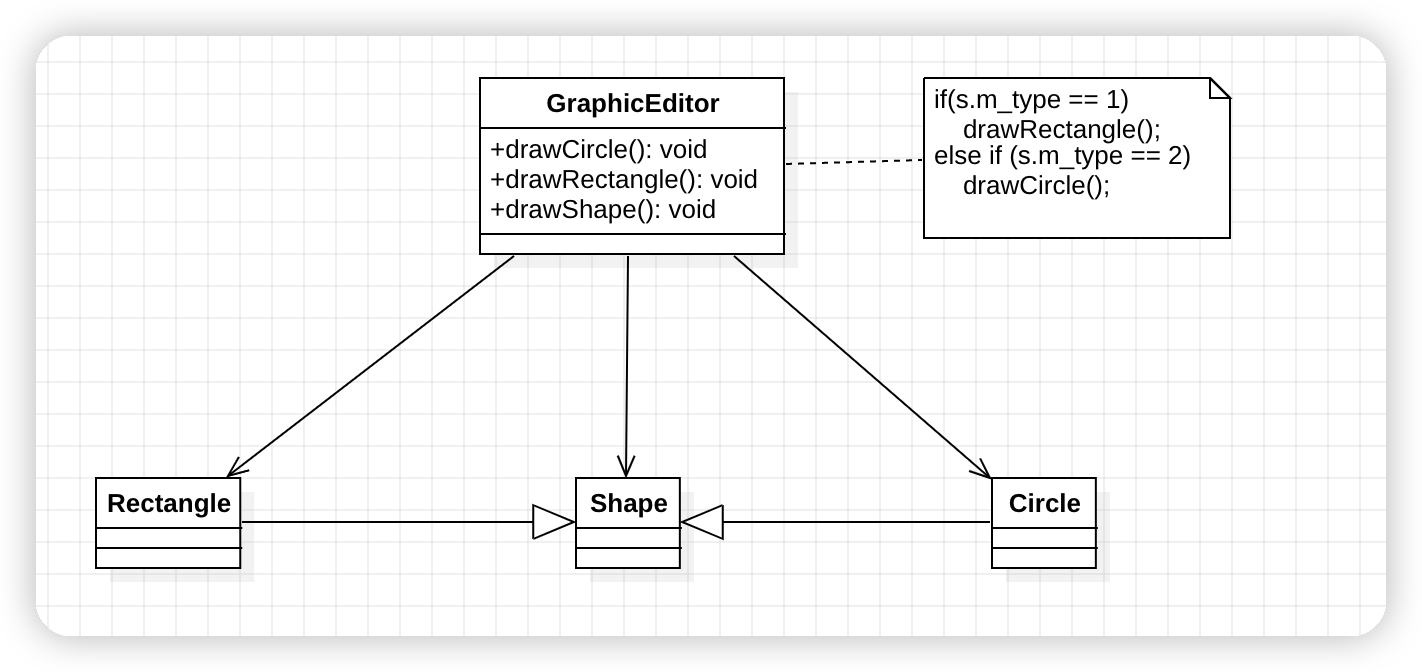1、基础介绍
1)开闭原则(Open Closed Principle)是编程中最基础、最重要的设计原则
2)一个软件实体如类,模块和函数应该对扩展开放(对提供方),对修改关闭(对使用方)。用抽象构建框架,用实现扩展细节。
3)当软件需要变化时,尽量通过扩展软件实体的行为来实现变化,而不是通过修改已有的代码来实现变化。
4)编程中遵循其他原则,以及使用设计模式的目的就是遵循开闭原则。
2、应用实例
下面是一个画图形的功能。
类图设计,如下:

代码演示:
package com.wenze.principle.ocp;
/**
* 开闭原则演示
*
* @author wenze
* @version 1.0
* @Date 2023-10-16 15:00:05
* @since 1.0
*/
public class Ocp {
public static void main(String[] args) {
// 使用看看存在的问题
GraphicEditor graphicEditor = new GraphicEditor();
graphicEditor.drawShape(new Rectangle());
graphicEditor.drawShape(new Circle());
}
}
/**
* 这是一个用于绘图的类
*/
class GraphicEditor {
/**
* 接收 Shape 对象,然后根据 type,来绘制不同的图形
* @param s Shape 对象
*/
public void drawShape(Shape s) {
if (s.m_type == 1) {
drawRectangle(s);
} else if (s.m_type == 2) {
drawCircle(s);
}
}
public void drawRectangle(Shape r) {
System.out.println("绘制矩形");
}
public void drawCircle(Shape r) {
System.out.println("绘制圆形");
}
}
/**
* Shape 基类
*/
class Shape {
int m_type;
}
class Rectangle extends Shape {
Rectangle() {
super.m_type = 1;
}
}
class Circle extends Shape {
Circle() {
super.m_type = 2;
}
}
3、方式 1 的优缺点
1)优点是比较好理解,简单易操作。
2)缺点是违反了设计模式的 OCP 原则,即对扩展开放,对修改关闭。即当我们给类增加新功能的时候,尽量不修改代码,或者尽可能少的修改代码。
3)比如我们这时要新增加一个图形种类,我们需要做如下修改,修改的地方较多
4)代码演示
package com.wenze.principle.ocp;
/**
* 开闭原则演示
*
* @author wenze
* @version 1.0
* @Date 2023-10-16 15:00:05
* @since 1.0
*/
public class Ocp {
public static void main(String[] args) {
// 使用看看存在的问题
GraphicEditor graphicEditor = new GraphicEditor();
graphicEditor.drawShape(new Rectangle());
graphicEditor.drawShape(new Circle());
graphicEditor.drawShape(new Triangle());
}
}
/**
* 这是一个用于绘图的类
*/
class GraphicEditor {
/**
* 接收 Shape 对象,然后根据 type,来绘制不同的图形
* @param s Shape 对象
*/
public void drawShape(Shape s) {
if (s.m_type == 1) {
drawRectangle(s);
} else if (s.m_type == 2) {
drawCircle(s);
} else if (s.m_type == 3) {
drawTriangle(s);
}
}
public void drawRectangle(Shape r) {
System.out.println("绘制矩形");
}
public void drawCircle(Shape r) {
System.out.println("绘制圆形");
}
// 新增画三角形
public void drawTriangle(Shape r) {
System.out.println("绘制三角形");
}
}
/**
* Shape 基类
*/
class Shape {
int m_type;
}
class Rectangle extends Shape {
Rectangle() {
super.m_type = 1;
}
}
class Circle extends Shape {
Circle() {
super.m_type = 2;
}
}
// 新增画三角形
class Triangle extends Shape {
Triangle() {
super.m_type = 3;
}
}
4、方式 1 的改进的思路分析
改进的思路分析
思路:把创建 Shape 类做成抽象类,并提供一个抽象的 draw 方法,让子类去实现即可,这样我们有新的图像种类时,只需要让新的图形类继承 Shape,并实现 draw 方法即可,使用方的代码就不需要修改 -> 满足了开闭原则
5、方式 2 来解决
1)方式 2 的设计方案:定义一个 Shape 抽象类。
2)代码示例:
package com.wenze.principle.ocp.improve;
/**
* 开闭原则-改进-演示
*
* @author wenze
* @version 1.0
* @Date 2023-10-16 16:05:54
* @since 1.0
*/
public class Ocp {
public static void main(String[] args) {
// 使用看看存在的问题
GraphicEditor graphicEditor = new GraphicEditor();
graphicEditor.drawShape(new Rectangle());
graphicEditor.drawShape(new Circle());
graphicEditor.drawShape(new Triangle());
graphicEditor.drawShape(new OtherGraphic());
}
}
class GraphicEditor {
/**
* 接收 Shape 对象,然后根据 type,来绘制不同的图形
* @param s Shape 对象
*/
public void drawShape(Shape s) {
s.draw();
}
}
/**
* Shape 基类
*/
abstract class Shape {
int m_type;
public abstract void draw();
}
class Rectangle extends Shape {
Rectangle() {
super.m_type = 1;
}
@Override
public void draw() {
System.out.println("绘制矩形");
}
}
class Circle extends Shape {
Circle() {
super.m_type = 2;
}
@Override
public void draw() {
System.out.println("绘制圆形");
}
}
// 新增画三角形
class Triangle extends Shape {
Triangle() {
super.m_type = 3;
}
@Override
public void draw() {
System.out.println("绘制三角形");
}
}
// 新增其他的图形
class OtherGraphic extends Shape {
OtherGraphic() {
super.m_type = 4;
}
@Override
public void draw() {
System.out.println("绘制其他图形");
}
}
3)从方式 2 看,代码满足了 OCP 原则



